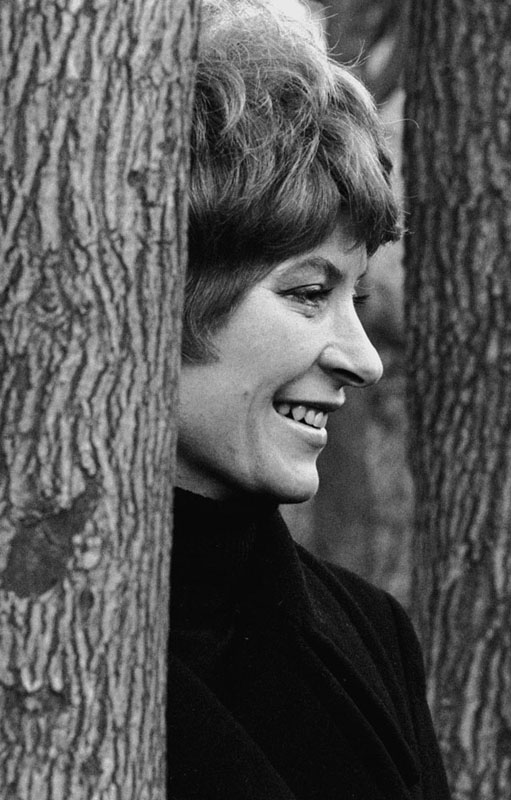SEVEN
The Whitsun Dance
The experiment with Davy was over, but I couldn't bear the thought of going to back to singing or recording with just my own five-string banjo or guitar accompaniments. I had always believed that English folk songs were so beautiful, the melodies so exquisite that they merited the best of arrangements – more than the standard everyday ones that were the norm. Of course, Nic Jones and Martin Carthy were streets ahead of everyone with their accompaniments, but I knew I could never reach that level with my own playing. Mine was minimal; it worked in its gentle, untaxing way, but it was no longer sufficient.
I was sitting one day in the living room at Blackheath mulling over this problem, when the thought floated into my mind that back in the Highgate days, when Alan Lomax was planning his book The Folk Songs of North America, he had commissioned two composers, Mátyás Seiber and Don Banks, to write keyboard arrangements. I hadn't ever heard them played, and suggested to John that we take the book to Dolly and get her to play them to see what they were like. She played the two songs I wanted to hear – ‘When A Man's in Love’ from Nova Scotia, and a stately Sacred Harp hymn ‘Through All the World Below’.1 Neither Dolly, John nor I were convinced by the arrangements; they sounded banal, lacking an understanding of the songs. I don't know why it hadn't occurred to the three of us that Dolly should try her hand at writing some arrangements – after all, she was both a composer and a pianist. She agreed to give it a try, and turned up a week or so later with her first attempt – a song set for three French horns! It was impossible to sing against, and I thought a baffling choice on her part, although she always was keen on pushing the boundaries! She took the rejection very well and promised to write for the piano. Meanwhile a miracle was waiting in the wings.
It was around this time that we discovered the portative pipe-organ, the beautiful flute-organ, a faithful reproduction built by the master organ maker Noel Mander of an instrument made in Bucharest in 1689. Dolly, John and I used to go along to the Early Music Centre in West London to sit and listen to the music, and the rehearsals. We'd had a love of Early and Renaissance music since we were teenagers, when Uncle Fred had introduced us to Monteverdi through his wind-up gramophone; and Mum, Dolly and I used to sing madrigals at home. One of them, Orlando Gibbons's ‘The Silver Swan’ had five parts, but as there were only three of us, Mum sang the soprano, Dolly the alto, while I had the bass!2 The minute we heard those first few notes of the little organ, we knew straightaway this was the instrument we'd been looking for. It would inspire us: Dolly to write for, and me to sing with. Not only was it beautiful to look at with its slender, squared wooden pipes, it also produced the sweetest, breathiest fluting notes. We never owned the flute-organ, it was far too expensive to buy, so we hired it from Noel Mander every time we recorded or were out gigging. Either Dolly's husband Dave Busby drove us, or later, her second husband Stuart Hollyer. It was slightly too large to fit into Stuart's estate car, and Noel Mander obligingly trimmed a tiny corner off. I've often wished I had that piece of wood as a souvenir. And it was there at The Early Music Centre that we first met David Munrow, the genius of Early Music. At that time he was playing in Michael Morrow's consort, Musica Reservata, from whom he would soon split to form his own Early Music Consort, but it proved to be a crucial meeting for us.
From then on, Dolly wrote for the flute-organ. To work with written arrangements was going to be new to me as a singer, but not a problem; Dolly was such a sympathetic musician, and she knew and felt the importance of my wanting an ‘English’ sound. She had a sublime sense of harmony and wrote such beautiful introductions to the songs that I could simply launch myself into the singing. When a song needed to be subtle or understated, that's what she wrote; or she could be triumphal and regal, or tender or full of sprightly joy. One of her loveliest arrangements was ‘The Streets of Derry’ that I'd learned from the singing of Irish singer Mrs Sarah Makem; Dolly making the flute-organ sound like uilleann pipes.
It was really pleasing that Dolly was now writing and arranging professionally. And she was wonderful to work with, both as a sister and an accompanist. I didn't have to change the way I sang; it was still my voice. Our first outing together was in 1967, recording The Sweet Primeroses, produced by John for Topic Records. The one downside to making this was that I'd had my tonsils out shortly before, and when I play the album now, I can hear a tentative quality to my singing (or perhaps I'm listening for it). We brought three people in to sing chorus, called for contractual reasons The Heathwood Friends. They were in fact The Young Tradition, Heather Wood, Royston Wood, Peter Bellamy (a bit of licence there for the French ami!).
On the fashion front, I was photographed by Brian Shuel for the cover wearing a sage-green corduroy trouser suit, very dashing with its high collar and brass buttons. It was made by Jeff Banks, the fashion designer, who was married to the singer Sandie Shaw at the time, at Clobber, his boutique in Blackheath Village.
My next task was to persuade Dolly to accompany me on gigs; I wanted audiences to hear the flute-organ and Dolly's transforming arrangements live. She was reluctant at first, nervous and shy of appearing in public, pointing out that she wasn't really a pianist, and certainly hadn't trained to actually perform on stage. But I said I'd do all the talking and singing – all she had to do was play.
By now Dolly had left Hastings and was living in Chingford with her husband Dave Busby, an art teacher and Morris dancer. They had married on 12 November, 1968 at Battle, in East Sussex, a memorable ceremony where the wedding party processed the length of the High Street behind a side of Morris Men dancing down through the town.
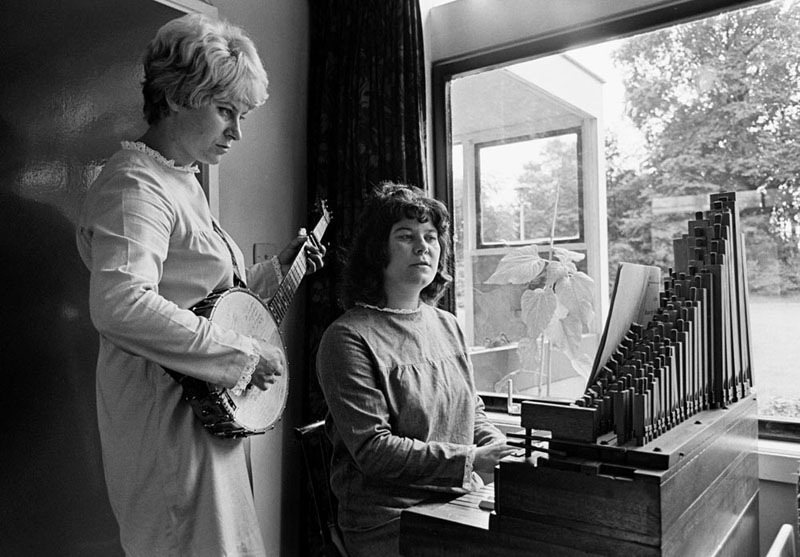
She was reluctant at first but, begged by me and persuaded by her husband, gave it a try. And so we became Shirley & Dolly Collins. I loved working with Dolly, having her there on stage with me. There was such sympathy between us, and as well as the beautiful music, lots of laughter.
Dolly began to enjoy the experience of gigging; after all, you never knew what might happen. One night we were interrupted mid-song by a shout from a chap in the audience, ‘Excuse me, miss – your organ's on fire!’ The audience laughed and gasped in turn. I turned to Dolly and sure enough there was smoke billowing lightly out from the back of the wooden base, from the electric motor that powered it. But soon both the organ and the audience were back under control and we continued.
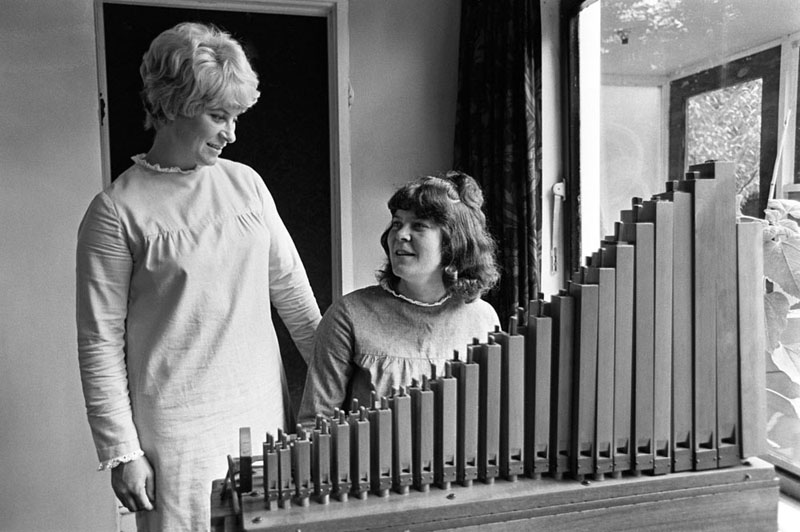
Our next album was The Power of the True Love Knot, recorded in 1968 for Polydor Records, with Joe Boyd as producer. Joe managed Sandy Denny, Fairport Convention and The Incredible String Band. Poor Joe – he didn't quite know what to make of me. He thought my singing was too plain and urged me to sell the song a bit more, put a bit of life into it! ‘Can you give it a bit more go?’ he asked at some point. I think he wanted me to be Sandy Denny! But I wasn't and never could be. I was pretty annoyed, and I certainly wasn't going to change what I did, what I was, just to please this young American, even though he was a powerful person in the music industry.
To add some lustre and fun to the album, Joe brought in Robin Williamson and Mike Heron of The Incredible String Band. They played percussion on Indian finger cymbals, African drum, Japanese finger sticks, and Robin on whistle and chanter. And as if that wasn't enough, they hand-clapped through ‘The Seven Yellow Gypsies’. Mind you, they did enhance a couple of tracks, it was fun, and they were – still are – the most charming of men, and uniquely talented, too. We became good friends from the very first; you couldn't help but love them and their music; beautiful, fey, Celtic, funny, and perhaps above all, wise.3
The Incredibles invited Dolly to arrange and play two or three songs on their 1968 album The Hangman's Beautiful Daughter. The only time I saw her angry with them was the occasion when Robin tried to persuade her to take some LSD, telling her that she couldn't see trees properly until she took the drug. She was enraged! It was quite the wrong thing to say to my sister whose knowledge of all things in nature was quite exceptional, and whose contempt (and fear) of people who took drugs was as strong as mine.
In October of that year we had a joint concert, October Songs, with The Incredibles at The Queen Elizabeth Hall. I still have a copy of the poster that Austin John designed. And Robin sent me a song, ‘God Dog’. In an interview for Swing 51 magazine he said:
I thought it would be a very suitable song for Shirley to sing because I'd always liked her voice. To me it's a very natural voice and because ‘God Dog’ is such an innocent song, – it's a child's song really, I didn't know anyone else who would be able to sing it. In the end, I guess I more or less wrote it for her.
Those are such precious words to me, and one of the best gifts I ever received, an honour. It would have to be sung on the next album, whenever and whatever that might be.
Nowadays, when people talk to me about our 1968 album The Power of the True Love Knot, they mostly remember the exquisite cello on the first track ‘The Bonnie Boy’ played by Bram Martin on his 1740 Testuri cello. As it says in the original sleeve-notes:
Mr Martin was able to grasp very quickly the idiom we were after: even, discreet and ‘wonderful warm’, two words from the second verse of the song.
On the original cover, I'm photographed by David Montgomery sitting in a meadow at the foot of the South Downs. I'm wearing a long dress made for me by my cousin Mary Ball, from a Liberty William Morris blue and green velvet, holding a beautiful instrument which I play on the album. I had commissioned it in 1967 from John Bailey; its body is shaped like a half of a mountain dulcimer, which is attached to a Victorian 5-string banjo neck. I could never think of a name for it – should it be a banjimer? A dulcimo? It is now called This Instrument after the heart-shaped label that John Bailey put inside it, that read ‘This instrument was made for Shirley Collins’, although I no longer have it. I sold it to musician and long-time friend Ian Kearey in the 1980s when I needed money and was no longer singing. Decades later Ian would be the musical director of my album Lodestar, on which he plays This Instrument, so in that sense it is still with me.
There are some things I've said, perhaps to get a cheap laugh that I am now ashamed of. One of these was to mock the elderly ladies who danced in such a genteel manner with each other at the country dances at Cecil Sharp House. That is until Austin John chided me one day and rightly so, pointing out that they were most likely women who had lost their husbands or sweethearts in the Great War. So he wrote ‘The Whitsun Dance’: ‘The feet that were nimble tread carefully now, As gentle a measure as age do allow’. The one redeeming feature of my insensitivity at that point was that had I not been so derisive, the song might never have been written… And what a loss that would be.
In my defence, the atmosphere at Cecil Sharp House for many years was so middle-class, so middle-aged, so lacking in energy. Outside the House was a stone bearing the words: ‘This building is erected in memory of Cecil Sharp who restored to the English people the songs and dances of their country.’ But remembering the difficulties I'd had trying to get into the library, it seemed to me that the English Folk Dance & Song Society was trying to keep the people away from their heritage. In 1960 Princess Margaret was made President of the Society; there are some illuminating photographs of her arriving at Cecil Sharp House one Christmas in evening dress, with her retinue all dressed formally. Dancers were so careful, toes were pointed daintily, skirts held up nicely. It all looked so polite, so joyless, rather as if dancing was more a duty than a pleasure. There was nothing about it that felt robust or of ‘the people.’ Thank heavens that was all to change in time.
I wanted to sing ‘The Whitsun Dance’, so I had to find a tune for it, one that would match the words. One tune persisted in my head, and that was the Copper Family song ‘The Week Before Easter.’ It fitted perfectly.
1: It's fifty-one spring times since she was a bride
But still you may see her at each Whitsuntide
2: The feet that were nimble tread carefully now
As gentle a measure as age do allow
Through groves of white blossom, through fields of young corn
3: The fields they are empty, the hedges grow free
No young men to tend them or pastures go see
4: Down from the green farmlands and from their loved ones
Marched husbands and brothers and fathers and sons
5: There's a straight row of houses in these latter days
Are covering the Downs where the sheep used to graze
There's a field of red poppies and a wreath from the Queen
When John wrote the poem he had in mind for the final verse the coastal town of Peacehaven, a few miles east of Brighton. It had been built after the Great War to house returning soldiers and their families, but of course the building encroached on the precious South Downs near to where the Copper family had lived for centuries. Bob Copper told the story of the time that he and his Dad, James Copper, were looking at the rash of new buildings ‘where the sheep used to graze’. James said ‘I don't know what your old grand-daddy would say, boy, if he could see this lot. “’Ouses, ’ouses ’ouses. Y’know, my boy, that makes me prostrate with dismal”’ (Bob Copper's Sussex, 1997.)
Whenever I sang ‘The Whitsun Dance’ I introduced it with the fact of the women's losses in The Great War, that they were left to dance alone. I told, too, of the maypoles, once the centre of so many village greens that were replaced by the war memorials.4 This song, which in its gentle way made such an impact, inspired our next album Anthems in Eden. The first side was a suite of traditional songs, the innocent Eden of England before ‘The Fall’ of the Great War. Yes, it could be held to be a romantic notion; was there ever a peaceful or innocent England? How could there be with such a dark and violent history as ours? The lives of the rural population had been torn apart in earlier times by the Enclosure Acts of the eighteenth and nineteenth centuries, depriving small farmers and peasants of their rights to graze their animals and grow crops on the common land, forcing people to leave to earn a living, splitting up rural communities throughout the land.
They hang the man and flog the woman
Who steal the goose from off the common
But leave the greater villains loose
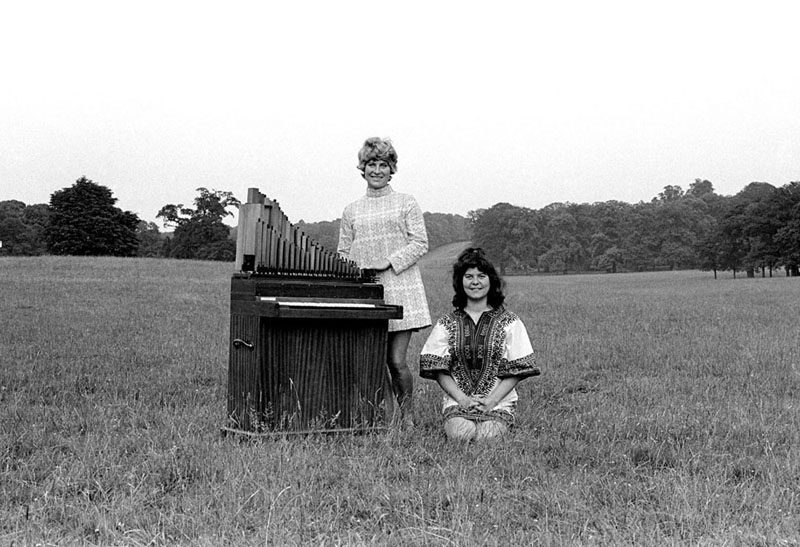
There was a further drift from the land with the coming of the Industrial Revolution, the rural population moving away from the land and into mill and factory towns to earn their livings. And then came the introduction of mechanisation into farming, more jobs and livings gone, people no longer needed.
And yes, I know that life wasn't a bed of roses in the countryside, and that there was dreadful hardship and poverty… and yet, so many of the songs are full of the pleasure of the landscape, the delight of birdsong, of the seasons, the freedom to walk out ‘on a May morning’, the pride in your work. To exchange that for life in ‘those dark Satanic mills’, still living in poverty, but now in cramped, crowded and unhealthy conditions, with very little beauty to see or fresh air to breathe, must have broken many hearts and spirits. Now, instead of being under the heel of landowners, they were up against the mill and factory owners.
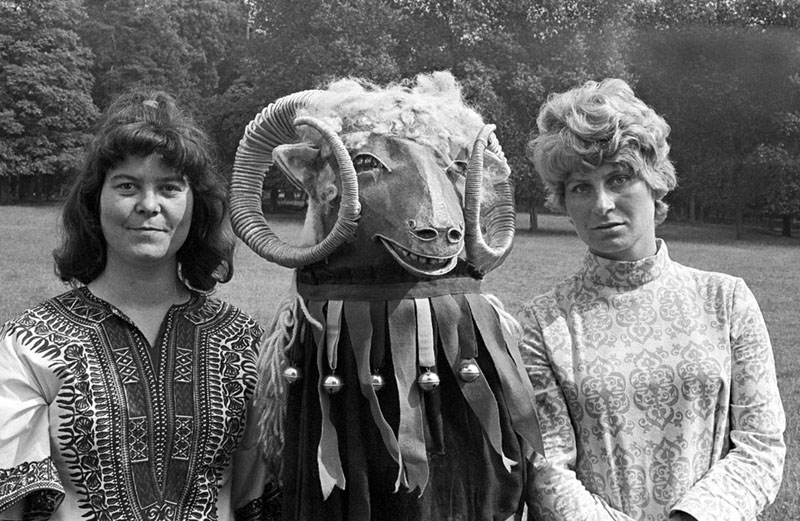
The Anthems suite told of yet another event that tore apart people all across the land – The Great War. It was made up of seven traditional songs depicting A Meeting, A Courtship, A Denying, A Forsaking, A Leave-Taking, An Awakening and a New Beginning, with ‘The Whitsun Dance’ and the powerful, primitive ‘Staines Morris’ ending the set.
John took Anthems to the BBC, and there we received encouragement from two people: John Peel, who played some of it on his Night Ride programme, and from a producer for Radio 1, Frances Line, who broadcast the whole suite on Radio 1 in August 1968. She later became Controller of Radio 2.
From that point, Austin John took the concept to Malcolm Jones who was masterminding EMI's new ‘underground’ label, Harvest, and Dolly and I were signed. Harvest existed to put out ‘progressive’ music that didn't fit either ‘mainstream’ or ‘popular’ styles. We were on the same listing as Deep Purple, The Edgar Broughton Band, Pink Floyd and Kevin Ayers. Dolly and I didn't exactly fit that list either, but it amused us that we were considered ‘underground’.
We played in the Harvest launch concert at The Roundhouse alongside these groups; I think the audience was a bit bemused at first. Someone heckled us, so I heckled back, and things got more appreciative after that.
Anthems was recorded at EMI's famed Abbey Road Studios, engineered by Peter Mew, produced by Austin John Marshall, with David Munrow as musical director; it was played by David and musicians from his Early Music Consort, and all the music was arranged and scored by Dolly. Those early instruments, rebec, viol, sackbut, racket, cornett, harpsichord, crumhorn, sordun, recorders and bells, and not forgetting the flute-organ, provided the perfect sound – natural, earthy and sympathetic. The musicians were Dolly, Christopher Hogwood, Oliver Brooks, Alan Lumsden, Roderick and Adam Skeaping, Michael Laird, Richard Lee and Gillian Reid, and for this album they were called ‘The Dolly Collins Sweet England Harmonious Band’. The chorus were folk friends Royston Wood of The Young Tradition, Steve Ashley and Home Brew (Mike Clifton, Ray Worman and John Fordham). Dolly was in her element; she had a proper commission, professional musicians of the utmost quality to write for and an association with David Munrow, who gave her his complete approval for her scores.
Working with David was an unforgettable experience; he was the most talented, energetic, enthusiastic and kind man, and the resulting music had great integrity, strength and beauty. I was keenly aware, though, in the studio, that everyone was working from a written score – except for me; I had never learned to read music as I had all the songs by heart. So when there was a point when there was a discussion about which bar they were working on and which bar I was to come in singing, I felt at an embarrassing disadvantage. It seemed pointless trying to keep this to myself, so I confessed to David that I couldn't read music. ‘That's OK – that's probably the right thing – the best thing for you,’ he said airily. ‘You know when to come in, anyway.’ He then went on to tell me that, as a young man, he had learned a great deal of his wind instrument technique and knowledge from folk musicians he'd met in South America, who naturally continued a handed-down tradition.
Mike Clifton, as well as being a singer, was also a Morris dancer with the Chingford Morris, and a talented potter, and it was he who made the beautiful slipware ceramic depicting Adam and Eve before ‘the Fall’. He had modelled the couple on Dolly and her husband Dave Busby – also a Chingford Morris man. Austin John designed the entire sleeve and used the ceramic on the front cover of Anthems. The centrefold was another of Mike's creations, a huge ram's head with curving gilded horns; there's a photograph of Dolly and me on either side of the ram that was taken at The Woburn Festival in 1968, where we were on the same bill as T.Rex and Jimi Hendrix!
Mike had also made a large, regal golden lion's head for Chingford Morris, and he amused us with his tale of the time he was stopped by police late at night after a Morris practice. He had driven over the newly opened (in 1967) Bow Flyover across the Thames, and was heading home when he was pulled over. One officer asked him where he had come from, and Mike, tetchy at being stopped, got muddled and said rather crossly ‘I've just come across the fly bow-over’. ‘Oh yes – and have you been drinking? What's in your boot?’ ‘No, I haven't been drinking,’ replied Mike, ‘and I've got a lion's head in my boot!’ And, of course, when he opened the boot of his car, there was… a lion's head. The cops simply had to let him go on his way.
We had a short tour of Anthems, taking with us a full complement of the early musicians as well as The Chingford Morris Men who danced for the finale, ‘The Whitsun Dance’ and ‘Staines Morris’. It was the start of a long working relationship with them… and they eventually became Albion Morris, dancing with the original Albion Band, the Albion Country Band, and The Albion Dance Band.
While the music was flowing freely for Dolly and me, this period was also the beginning of the breakdown of my marriage to Austin John. In so many ways we were unsuited, right from the start. I remember a rather telling moment early on in our marriage, in 1963, while we were still living in Maida Avenue, when I was being photographed by a rather eminent Czech for the cover of the Topic EP Heroes in Love. As he walked around the room taking pictures, I heard him mutter to himself ‘Who chose who here?’ It didn't seem significant at the time, but it stayed with me.
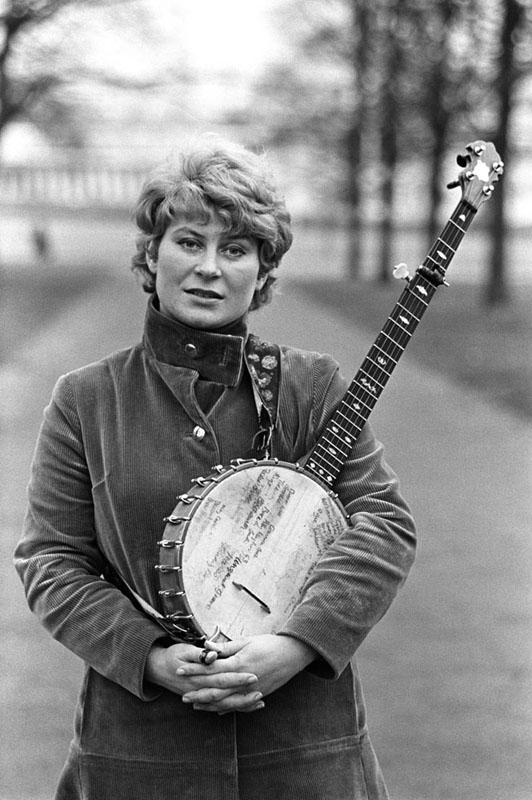
Our life together was floundering and foundering over a thing that might appear petty: John loved jazz and I hated it. You wouldn't think that this could cause such a difference between us, but it did, and it was a crucial one. At first I tolerated Charlie Mingus, Ornette Coleman, Charlie Parker on the gramophone so much of the time… too much of the time. It simply wasn't music that I could understand, let alone enjoy, and I grew more and more intolerant simply watching John listen to it – the snapping fingers, the nodding head, the twitching legs and feet, the almost religious fervour of the light in his eyes. I'd always felt that jazz was alien to me; it belonged in dark clubs in the night-time, nothing of sunlight or fresh air or the outdoors. I minded the way jazz musicians dressed – silly pork-pie hats, and the way bass players leaned over their instruments, chewing their lips in rhythm to their playing; it made me squirm.
There were two occasions when I became so angry that I threw two full cups of coffee against the kitchen wall, and worse, when I dragged down the two heavy William Morris curtains from the big picture windows in the sitting room. Such acts leave you with far more clearing up and repairing than warrants the act in the first place – but I was enraged!
Looking back, it seems ungrateful. John was such a supporter and promoter of music – not only of Dolly's and mine, but of Steve Ashley's too, who he worked with for years, producing Steve's 1974 album Stroll On. Steve and I recorded John's song ‘Honour Bright’ (available on Within Sound), from a ballad opera that John was writing, The Anonymous Smudge, who stood as ‘the everyman soldier’. Sadly, Smudge never had a performance in England, but years later in 1981, when John had moved to New York, it was broadcast on the radio station WBAI. In 1978 he wrote The Blackbirds of Brittany with Bert Jansch, a protest in song following the catastrophic oil spill off the coast of Brittany which killed untold thousands of seabirds. His heart was always in the right place.
John was also filming Jimi Hendrix. He had interviewed Jimi shortly after his arrival in England in August 1967; the article was published in The Observer that December. One unforgettable summer's day (in 1968 or ’69) Jimi visited us in Blackheath. We had been to see him in concert; he had such presence and his songs were original and great and his performance beautiful, exciting and charged with danger. I sat gasping at the sounds he produced from his guitar and anxious about his teeth when he used them on the strings! For Jimi to come to our home was a thrill and a pleasure; he was handsome, playful, teasing, sweet and graceful. He sat Polly on his knee; she'd have been about six or seven years old and was enchanted by him, gazing raptly into his face. I have no photographs of this occasion (we didn't own a camera, can you believe) – just the memory of him touching my bare arm and whispering close in my ear, ‘I can see why John married you.’ I felt a little guilty about being so thrilled, but it's a memory I still cherish!
But I was angry a lot of the time, and despondent that John spent so much time out in the evenings; domestic life wasn't of great interest to him, and I felt he neglected the children. And when he was home, he spent what seemed like endless hours on the phone, reading The Anonymous Smudge to people. There must have been some happy times, but they were overshadowed.
The breaking point came when, late one night, John brought a young drug-addicted jazz player that he'd befriended back with him, and insisted that he stay for a few days, very much against my will. He moved Polly out of her little bedroom and made her share with Rob. This ‘guest’ would often come back in the early hours of the morning, then sleep throughout the day. One night around ten o’clock, when he and John were out at a jazz club together, and I was alone in the house with the children, there was a loud knock on the door, and there stood two South London heavies. They were from a mini-cab firm and wanted the money there and then that our guest owed them for several late-night fares. It was a sizeable amount. I apologised to them, wrote out a cheque and handed it over. When they'd gone, my knees buckled and I started to shake with fright and anger. I didn't wait up for John and the young man. I'd had enough. The next day, I threw the jazz musician out. John apologised to him… But not to me.
Go from my window, my love, my dove, go from my window, my dear
Go from my window, my love, my dove, go from my window, my dear
Go from my window, my love, my dove, go from my window my dear
Go from my window my love, my dove, go from my window my dear
Go from my window, my love, my dove, go from my window my dear
O the devil's in the man that he will not understand
We still had one album left to record while we were together, again for EMI's Harvest label: Love, Death & the Lady. Reflected in it, running through it, are all the difficulties, the sadness, the despair and, perhaps, also the relief of our marriage breaking up. There were some fine songs on the album including ‘Death & The Lady’, ‘The Oxford Girl’ and ‘Six Dukes’. But perhaps the finest was ‘The Plains of Waterloo’, dating from the Napoleonic Wars, true lovers eventually re-united after being tested for their fidelity – a broken-token song. Dolly's arrangement was steady, stately, beautiful. There are a couple of verses where the story moves to the battlefield, and John suggested that we use percussion there. I wasn't keen at first, drums meant jazz, but agreed to give it a go, and it became a most telling moment, powerful and right, and so subtle in Terry Cox's hands.
If Willy Smith's your true love's name then he's a hero of great fame
He and I have fought in battle through many's the long campaign
Through Italy and Russia, through Germany and Prussia
He was my loyal comrade through France and through Spain
Till at last by the French oh then we were surrounded
And like heroes of old then we did them subdue
And on the fifteenth day of June it is ended the battle
Leaving many's the bold hero in sorrow to mourn
Where the war drums they do beat and the cannons loud do rattle
It was by a French soldier your William was slain
And as I passed by, oh to where he lay a-bleeding
I scarcely had time for to bid him adieu
It was certainly a less happy experience than Anthems had been; the unravelling of the marriage was present all the time, although I was grateful to John for producing a good album and art work. This time, the mood was bleak, Dolly and I photographed in black cloaks, with very serious, severe expressions. Dolly's arrangements were more spare, stark often, fitting the mood of the songs. Again she wrote her score for early instruments and the same musicians, with the addition of Eleanor Sloane on rebec, with only one folk musician, Peter Wood, on concertina. Dolly said, years later in an interview, that these arrangements had ‘a more classic approach, more modern chords. I was trying things out, pushing ahead, experimenting all the time.’
One reviewer wrote: ‘Shirley Collins comes of age’, and that was probably true. Later, Karl Dallas wrote of John that he was ‘one of the great unsung pioneers of contemporary British folksong’ and that was certainly true. Love, Death & the Lady was released in 1969, by which time John and I had separated. He had moved back to central London, and I was relieved and happy for him that he'd formed a new relationship. As, a little while after, had I. I stayed in Blackheath with Polly and Rob until my divorce came through. I remember that day – I had a booking at Exeter University that evening, and wished I could stay home, but duty prevailed. At the gig I mentioned that I was now officially divorced. A small cheer went up from the audience!
The little Span house was put up for sale, and I started packing, preparing to escape back to Sussex. I'd been away too long.
